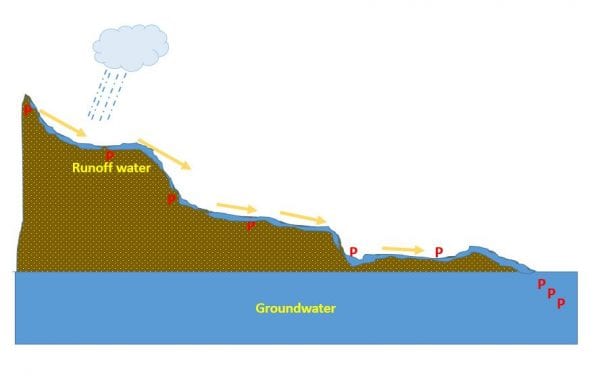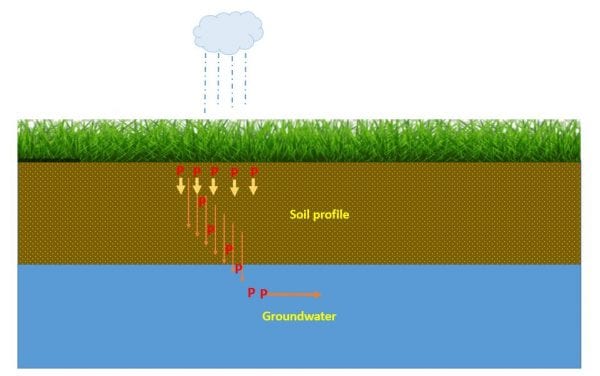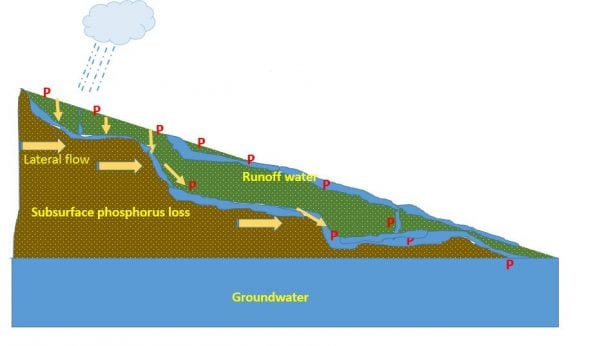Crop Production

Educating ourselves about how phosphorus enters water bodies is important for agroecosystem management. Learn about phosphorus loss pathways from phosphorus-enriched soils.
Phosphorus (P) is one of the primary nutrients essential for plant growth. However, excess application of phosphorus fertilizers and manures can cause a buildup of phosphorus in soil. When phosphorus bound to soil is transported to water bodies, it can potentially increase the growth of undesirable algae and aquatic weeds—a process commonly known as eutrophication.
Some species of algae produce toxins, which can further degrade the water quality. Additionally, excess algal growth can reduce oxygen levels in water that may lead to fish kills. The amount of phosphorus that can potentially trigger water quality issues is very low (0.08 to 0.1 parts per million). The United States Environmental Protection Agency has recommended a limit of 0.1 ppm for total phosphorus in flowing streams for monitoring purposes
Phosphorus Loss Pathways
Unlike carbon (C) and nitrogen (N), phosphorus from agricultural areas does not form gases. As a result, phosphorus loss is generally linked to geology (soils) rather than to other processes. For phosphorus to move from landscapes into water sources, there must be a source of phosphorus, such as a fertilized field or a geologic deposit, and a transport process that will carry the phosphorus to nearby water bodies.
Water is the primary driver of phosphorus loss. Loss of phosphorus from land to a water body is in the form of dissolved phosphorus (water-soluble) and particulate (eroded soil particles) phosphorus. When rainwater falls on soil surfaces, a portion of the phosphorus associated with the soil is dissolved in water. This phosphorus is called dissolved phosphorus. When fine soil particles like clay or coarser particles like sand are transported by water via runoff, they can carry phosphorus that is bound to the particles. This process is called erosion, and the phosphorus that moves along is called particulate phosphorus. Thus, erosion control is important to minimize particulate phosphorus loss from any land.
Phosphorus can move into water bodies through three pathways: (1) surface runoff, (2) leaching, and (3) subsurface flow.
(1) Surface runoff is a water-assisted downhill transport process that causes phosphorus to move with water either in dissolved or particulate form from the top 2 inches of soil (figure 1). Surface phosphorus runoff increases for soils that have a greater slope. The intensity and distribution of rainfall as well as vegetation and land cover affect the amount of phosphorus transported through runoff. When soil tests high in phosphorus, it usually results in high dissolved phosphorus concentrations in runoff water. When soil tests low in phosphorus, a runoff event will result in a small amount of phosphorus loss. However, with several runoff events, the total amount of dissolved phosphorus loss may be significant.

Figure 1: Surface runoff of phosphorus
(2) Leaching is the downward movement of water along a soil profile (figure 2). Percolating water carries the dissolved phosphorus deeper into the soil profile. How deep the phosphorus is transported depends on the soil texture. However, as the dissolved phosphorus moves down the soil profile, the subsoil acts as a filter and can tightly retain phosphorus. This process slows phosphorus from moving deeper into the soil. Continuous additions of phosphorus from surface soils can exhaust the phosphorus retention capacity of the lower soil horizons, which can allow phosphorus to leach into the groundwater. This process takes a long time if there is a clay layer in the subsoil. Downward movement of phosphorus by leaching is negligible in comparison to surface runoff for most of the Alabama soils except deep sands.
Phosphorus leaching is favored under the following conditions:
- Surface soils test high or excessive in phosphorus and a continued loading of phosphorus occurs in surface soils.
- When the subsoil has low iron and aluminum oxide concentrations to retain phosphorus.
- When percolating water moves through soil cracks rather than the soil matrix into underground water. This is typical in Karst systems or unconfined aquifers.
- Lands with tile drainage

Figure 2: Leaching of phosphorus
(3) Subsurface phosphorus loss occurs when phosphorus dissolved in percolating water travels horizontally below the soil surface but above the water table through lateral flow processes (figure 3). One such example is open ditch networks. These ditch networks can be a significant source of phosphorus transport from fine-textured soils having elevated phosphorus concentrations. Tile drainage is another example of a subsurface phosphorus loss source. Subsurface P loss is not common in Alabama soils.

Figure 3: Subsurface loss of phosphoru
Factors Affecting Phosphorus Loss
The factors that increase or promote phosphorus loss from landscapes are as follows:
- Storm events. Manures or inorganic phosphorus fertilizers such as diammonium phosphate (DAP) or monoammonium phosphate (MAP) applied to the soil surface represent a highly soluble source of phosphorus that can easily move with runoff water. Storm events that immediately follow the application of manure or fertilizer can result in high phosphorus loss through runoff. The loss of dissolved phosphorus during these rainfall events is proportional to the amount of fertilizer or manure applied. With time, the dissolved phosphorus concentration in runoff events decreases as phosphorus from fertilizers or manures is incorporated into the soil. Farmers should always check the weather before planning phosphorus applications.
- Decomposition of vegetation. Landscapes that have large amounts of decomposing plant residue or organic matter at the soil surface can potentially release greater amounts of dissolved phosphorus during spring warm-up. During rainfall events, this dissolved phosphorus is flushed along with surface runoff and contributes as a main source of phosphorus in water bodies.
- Excess and repeated application of manure and fertilizers. Repeated applications of manure to a landscape often result in the buildup of soil phosphorus. Such land serves as a phosphorus hot spot (source of phosphorus) and releases phosphorus during storm events. Soil testing every 2 years and applying phosphorus fertilizer based on university soil test recommendations can help prevent the buildup of such phosphorus hot spots.
- Overgrazing. Overgrazing of pastures reduces vegetative land cover and can promote soil erosion. If livestock grazing areas are not rotated, it can result in excess nutrients in a specific area that can serve as a hot spot of phosphorus during rainfall events. Rotational grazing is effective in reducing runoff and soil erosion.
- Fall applications of manure. Plant growth is minimal in the fall and winter months. Any manure or phosphorus fertilizer application during a rainy winter season has a high potential for loss because of limited nutrient uptake.
Debolina Chakraborty, Research Fellow; Rishi Prasad, Extension Specialist, Assistant Professor; Eve Brantley, Extension Specialist, Professor, all with Crop, Soil, and Environmental Sciences at Auburn University
Reviewed May 2022, Phosphorus Basics: Understanding Pathways of Soil Phosphorus Loss, ANR-2662

